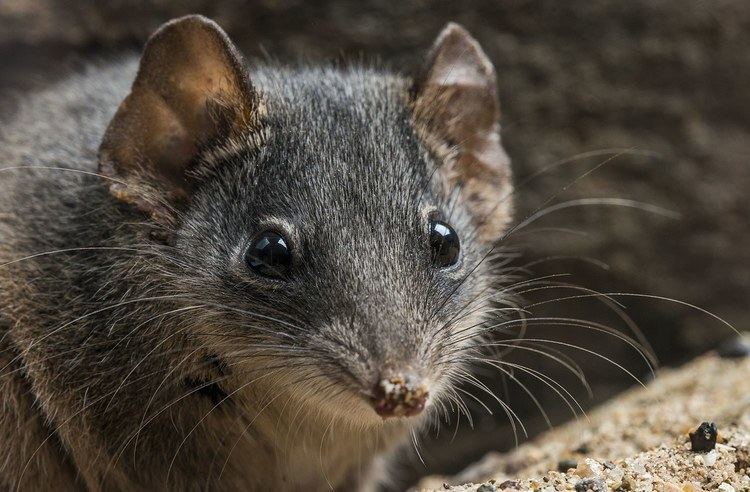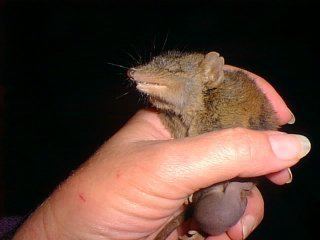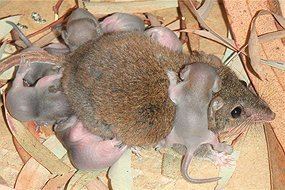Scientific name Antechinus Rank Genus | Phylum Chordata Higher classification Phascogalini | |
 | ||
Lower classifications Brown antechinus, Yellow‑footed antechinus, Dusky antechinus, Agile antechinus, Swamp antechinus | ||
Qld the suicidal mating routine of the male marsuipial antechinus
Antechinus /æntɪˈkaɪnəs/ ('ant+echinus' – resembling a mouse with the bristly fur of a hedgehog) is a genus of dasyurid marsupial that is indigenous to Australia (including Tasmania and some outlying islands) and New Guinea. The majority of Antechinus species occur in Australia and only two species (currently with a putative third) have been described in New Guinea. Members of this species have been called broad-footed marsupial mice, pouched mice, route rat or antechinus shrews. However, these common names are to be considered either regional or archaic and the modern common name for animals of this genus is 'antechinus'.
Contents
- Qld the suicidal mating routine of the male marsuipial antechinus
- Antechinus mating
- Reproduction
- Species
- References

Antechinuses are small, carnivorous, shrew-like animals that primarily prey on invertebrates such as spiders, beetles (including larvae), and weevils. Some are strictly terrestrial and hunt only at ground level, while others are highly scansorial (climbing) in nature. Most species nest communally in tree-hollows.

Their habitat is primarily: temperate rainforest, dry and wet eucalypt forest, healthy woodlands (A. agilis / A. stuartii); temperate rainforest (A. swainsonii); swamps, wet heaths (A. minimus); disturbed or open woodlands, dry/wet, tropical/subtropical/temperate eucalypt forest/rainforest, healthy woodlands (A. flavipes [highly widespread]); tropical rainforest (A. godmani, A. leo); tropical/subtropical vine-forests (A. subtropicus, A. adustus); monsoonal open forest (A. bellus).

Antechinuses have short hair and vary from grey-cinnamon-brown-black in colour depending on the species. They have prominent whiskers, large ears and a pronounced, pointed snout, giving them an overall shrew-like appearance. Species vary from 80–120 mm, nose-to-tail (80 mm = female A. agilis, 120 mm = male A. swainsonii) and weight 16–170 g (16 g = female A. agilis, 170 g = male A. swainsonii) when fully grown.

Sexual dimorphism occurs in most species for both weight and skeletal measurements, with males being typically larger and heavier. A. agilis is the smallest known species, and A. swainsonii the largest. Species in Papua New Guinea are not well documented and unknown Papuan species and subspecies likely await discovery.

Antechinus mating
Reproduction

All Antechinus species except for A. swainsonii are semelparous at least as males – and usually as females, too – meaning that an individual usually only lives long enough to breed once in its lifetime. Breeding occurs in winter (usually August–September) at a time when little food is available in the environment.
To accomplish this, a male strips its body of vital proteins and also suppresses the immune system so as to free up additional metabolic energy. In this way, an individual male trades away long-term survival in return for short-term breeding success, and following the breeding season, a complete die-off of physiologically exhausted males occurs. Breeding is intensely competitive. Males produce large amounts of testosterone and mate-guarding occurs in the form of protracted copulation (up to twelve hours in some species).
The females can store sperm for up to three days in specialized sperm-storage crypts in the ovary and do not ovulate until the end of the breeding season. Many litters have multiple paternity (i.e. several fathers contribute to a single litter). Females can live for 2–3 years. However, this is unusual, and most females die following the weaning of their first litter. Litter size depends on the number of teats in the pouch.
As few as four teats, usually eight, and in some populations up to ten, can occur. The cause of this variation in number is unknown, but in food-poor environments, selection likely has tended towards fewer teats, so that greater parental investment occurs per offspring.
Antechinus babies can weigh as little as 4 grams and are some of the smallest Australian marsupial babies.
